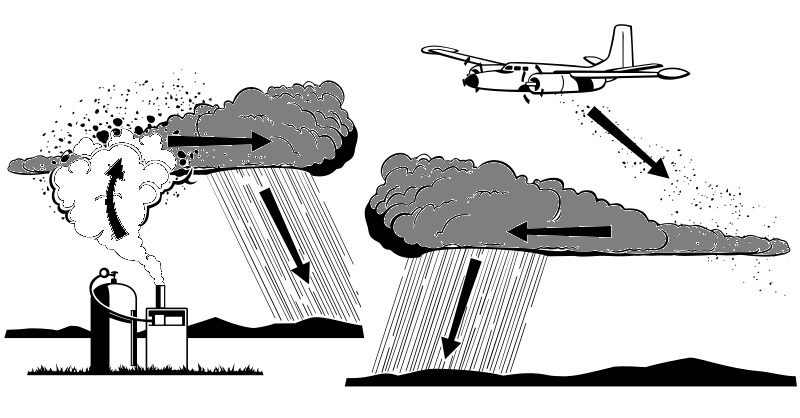
Geoengineering is an intentional, large-scale intervention in the Earth’s natural processes to prevent the effects of climate change. This entails using physical methods to alter the global climate to chill the globe. Solar radiation control, carbon dioxide removal, and weather manipulation are the three main categories of these methods.
Large-scale interventions may have a higher risk of altering natural systems, posing the problem that techniques that may be highly cost-effective in mitigating extreme climate risk may also pose a significant risk. Some argue that geoengineering will reduce political and public pressure to reduce pollution emissions and the worsening of overall climate risks. In contrast, others say that the fear of geoengineering will encourage emissions reductions. Let us know what the reality is.
Contents
What is Geoengineering?
Geoengineering, also known as climate engineering, is the purposeful manipulation of the Earth’s climate system to reverse climate change’s effects on a large scale. This involves using physical methods to alter the global climate to reduce Earth’s temperature.
According to Oxford Languages, Geoengineering is the deliberate large-scale manipulation of an environmental process that affects the Earth’s climate to counteract the effects of global warming.
According to the Intergovernmental Panel on Climate Change (2012), Geoengineering is a broad set of methods and technologies that aim to deliberately alter the climate system to alleviate the impacts of climate change. Most, but not all, strategies seek to either reduce the amount of absorbed solar energy in the climate system (Solar Radiation Management); or increase net carbon sinks from the atmosphere at a scale sufficiently large to alter climate (Carbon Dioxide Removal)
Weather modification or weather control is purposefully influencing or modifying the weather. The most common form of weather modification is cloud seeding, which increases rain or snowfall, usually to improve local water supplies.
Experts argue that weather modification can prevent adverse weather like hail or hurricanes. Others say that it can also be used for military purposes, for example, to provoke climate against the enemy to destroy their resources, as done in Operation Popeye, where lousy weather was pressed against the enemy. To learn whether the modification or geoengineering is for military purposes, read this article – Weather Warfare.
Types of Geoengineering
Solar geoengineering and carbon dioxide removal are the two most common types of Geoengineering. To restrict or reverse human-caused climate change, solar geoengineering, or solar radiation modification, would reflect some sunlight (solar radiation) to space. Carbon dioxide removal is the process of extracting carbon dioxide from the atmosphere and storing it for a long time. Solar geoengineering modifies the planet’s shortwave radiation budget, whereas carbon dioxide removal modifies its longwave radiation budget.
Weather modification or weather control is also another type of geoengineering. The most common form of weather modification is cloud seeding, which increases rain or snow, usually to improve the local water supply.
Prevention from Climate Change or Unknown Climate Risk
Some argue that geoengineering will reduce political and public pressure to reduce pollution emissions and the worsening of overall climate risks. In contrast, others say that the fear of geoengineering will encourage emissions reductions.
Geoengineering techniques are sometimes considered viable complementing alternatives for minimizing climate change or its consequences, lowering greenhouse gas emissions, and adaptation. Scientists are unified in their belief that solar geoengineering and carbon dioxide removal are insufficient to reduce emissions. However, given the economic, political, and physical limits of all climate change solutions, specific Geoengineering techniques may eventually be utilized as a part of an ensemble of responses with the goal of climate restoration.
However, there are notable uncertainties about the effectiveness, side effects, and unanticipated implications of such treatments; most scientists say that the risks of such actions must be weighed against the dangers of catastrophic climate change. Moreover, large-scale interventions may pose a more significant risk of altering natural systems, creating a difficulty in which techniques that may be highly cost-effective in mitigating extreme climate risk may themselves pose substantial risk.
Conclusion
Geoengineering is a large-scale deliberate attempt to alter the climate. It would be different from the large-scale burning of fossil fuels, which affects the environment. From a moral viewpoint, humans have no authority to alter the climate intentionally; besides, if they do, then in what circumstances? For example, there may be a moral difference between geoengineering to reduce global warming and geoengineering to improve the climate. Furthermore, ethical debates frequently address broader worldview issues, such as individual and social-religious convictions.
Sources
- Geoengineering the climate: science, governance, and uncertainty. Royal Society. London: Royal Society. 2009. ISBN 9780854037735. OCLC 436232805.
- “Geoengineering – Giving us the time to act?”. I Mech E. Archived from the original on 2011-07-22. Retrieved 2011-03-12.
- A working group (2009). Geoengineering the Climate: Science, Governance, and Uncertainty (PDF) (Report). London: The Royal Society. p. 1. ISBN 978-0-85403-773-5. RS1636. Accessed on July 18, 2021.
- Zahra Hirji (October 6, 2016). “Removing CO2 From the Air Only Hope for Fixing Climate Change, New Study Says; Without ‘negative emissions’ to help return atmospheric CO2 to 350 ppm, future generations could face costs that ‘may become too heavy to bear,’ paper says”. insideclimatenews.org. InsideClimate News. They were accessed on July 18, 2021.
- “Geoengineering.” International Risk Governance Council. 2009. Archived from the original on 2009-12-03. Retrieved 2009-10-07.
- Oxford Languages and Google – English | Oxford Languages. (2021, April 9). Oxford Languages. https://languages.oup.com/google-dictionary-en/
- Joint Expert Meeting of WG I, WG II, and WG III on Geoengineering. (n.d.). IPCC. Retrieved July 19, 2021, from https://www.ipcc.ch/event/joint-ipcc-expert-meeting-of-wg-i-wg-ii-and-wg-iii-on-geoengineering/
- Gelt, Joe. “Weather Modification: A Water Resource Strategy to be Researched, Tested Before Tried.” The University of Arizona. Archived from the original on June 5, 1997. Accessed on July 18, 2021.
- http://rednet.solutions. “Operation Popeye, Motorpool, Intermediary, Compatriot: Weather Warfare Over Vietnam · Weather Modification History.” weathermodificationhistory.com.
- “United Nations Treaty Collection.” treaties.un.org. Accessed on July 18, 2021.
- Lenton, T.M.; Vaughan, N.E. (2009). “The radiative forcing potential of different climate geoengineering options.” Atmospheric Chemistry and Physics. 9 (15): 5539–5561. Bibcode:2009ACP…..9.5539L. doi:10.5194/acp-9-5539-2009.
- “Geoengineering – Giving us the time to act?”. I Mech E. Archived from the original on 2011-07-22. Retrieved 2011-03-12.
- A working group (2009). Geoengineering the Climate: Science, Governance, and Uncertainty (PDF) (Report). London: The Royal Society. p. 1. ISBN 978-0-85403-773-5. RS1636. Accessed on July 18, 2021.
- Zahra Hirji (October 6, 2016). “Removing CO2 From the Air Only Hope for Fixing Climate Change, New Study Says; Without ‘negative emissions’ to help return atmospheric CO2 to 350 ppm, future generations could face costs that ‘may become too heavy to bear,’ paper says”. insideclimatenews.org. InsideClimate News. They were accessed on July 20, 2021.
- “Geoengineering.” International Risk Governance Council. 2009. Archived from the original on 2009-12-03.
FACT CHECK: We strive for accuracy and fairness. But if you see something that doesn’t look right, please Contact us.
DISCLOSURE: This Article may contain affiliate links and Sponsored ads, to know more please read our Privacy Policy.
Stay Updated: Follow our WhatsApp Channel and Telegram Channel.












